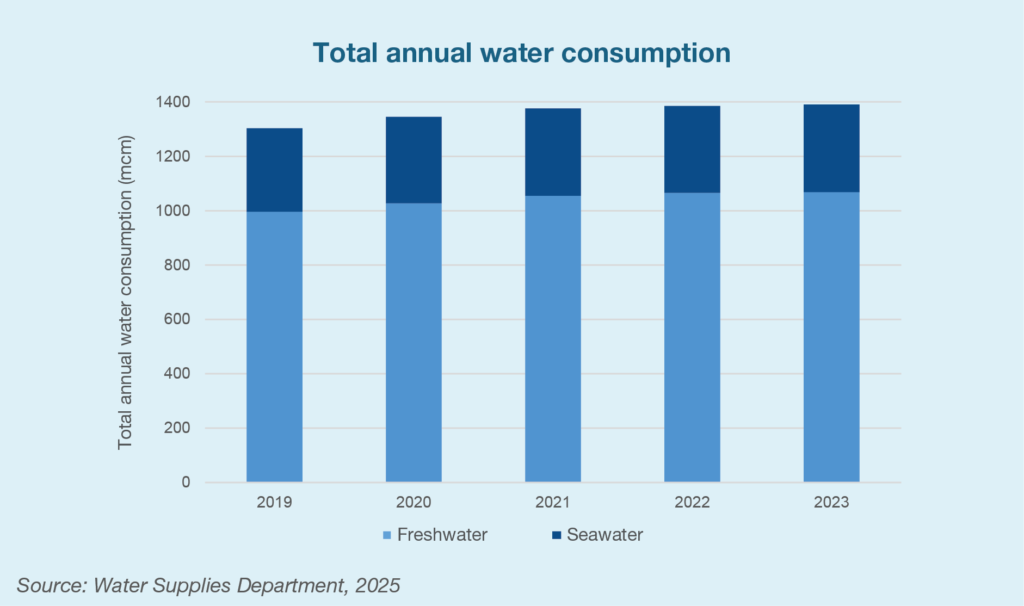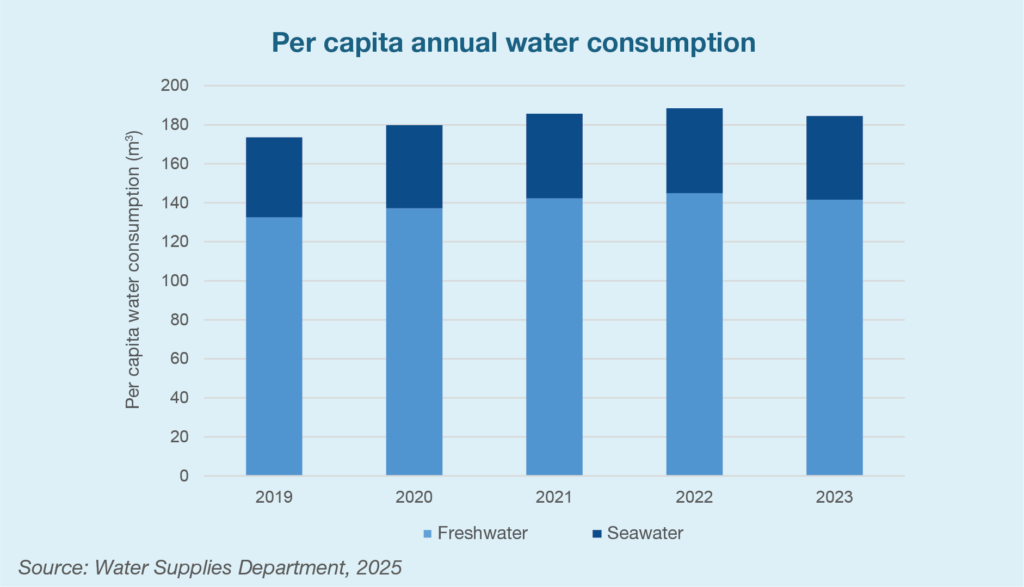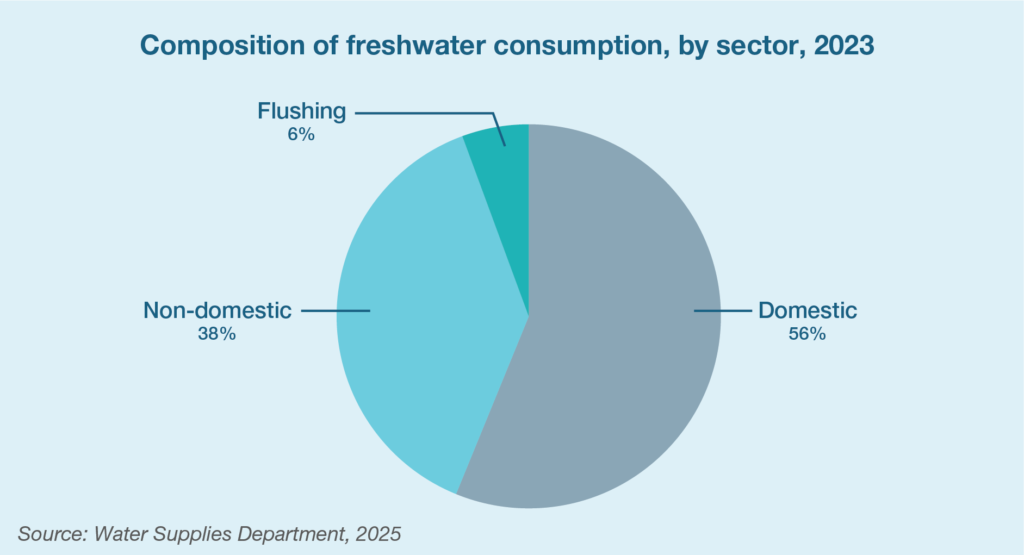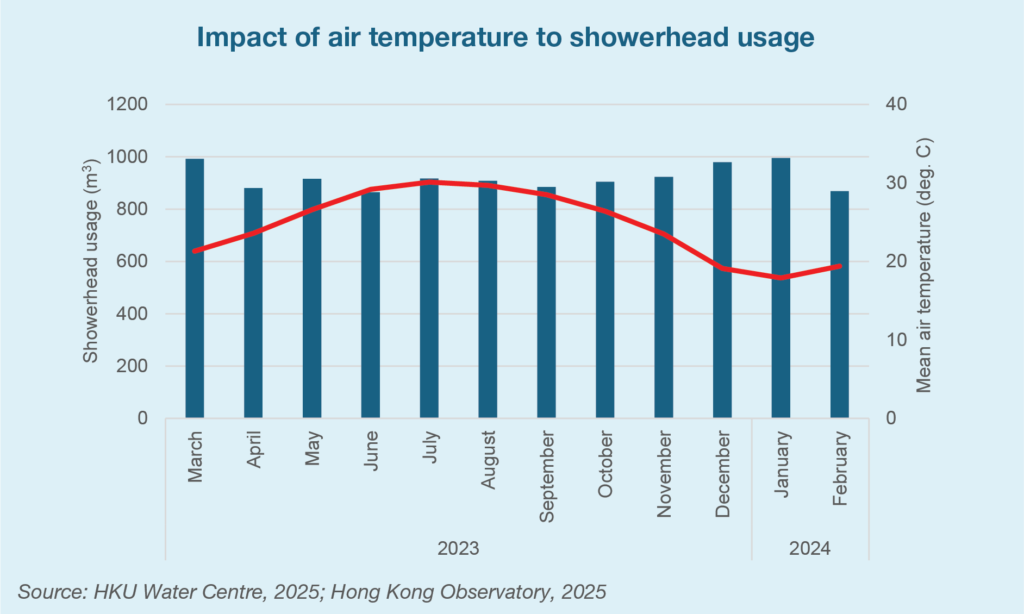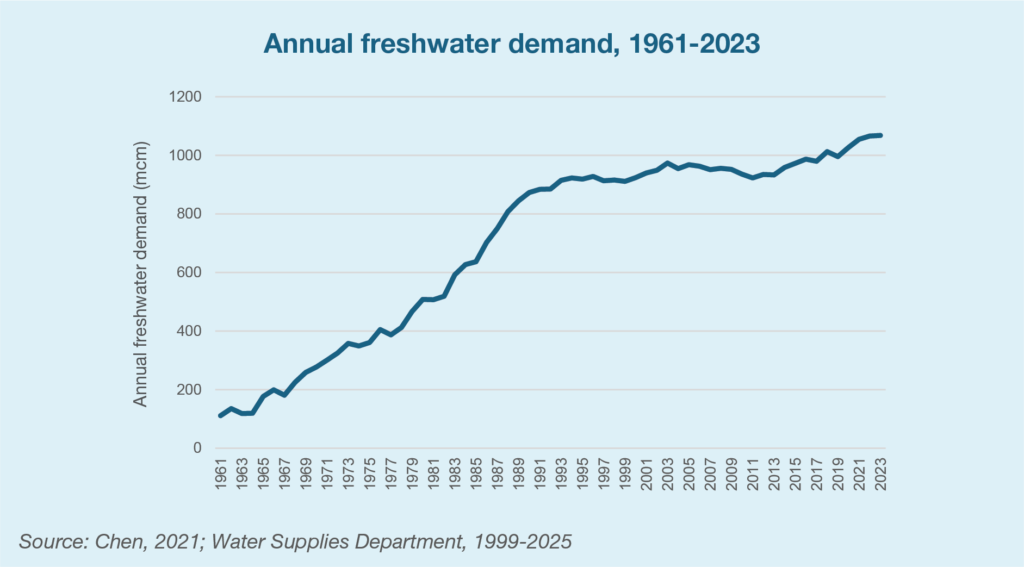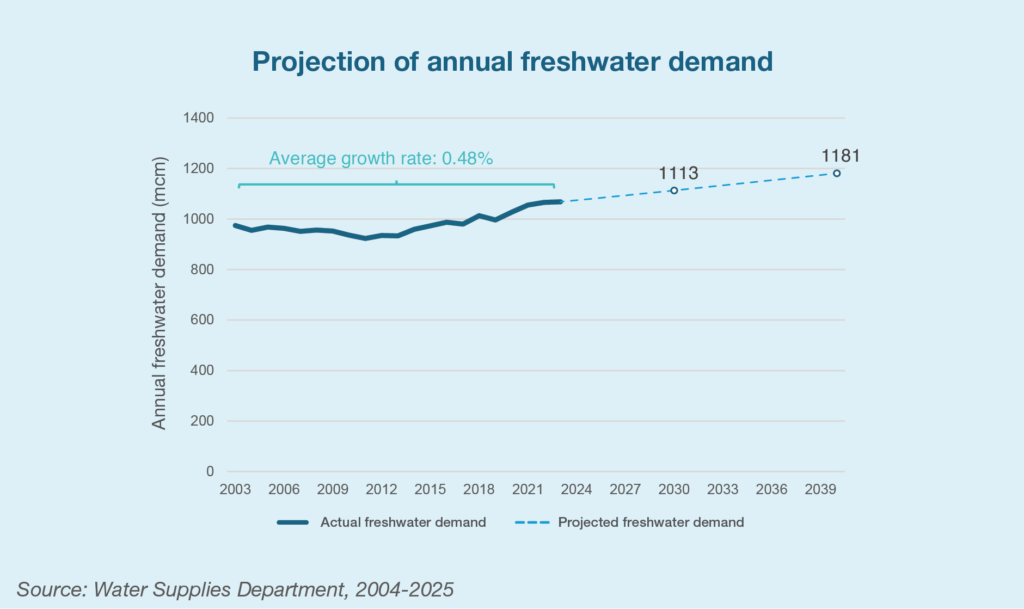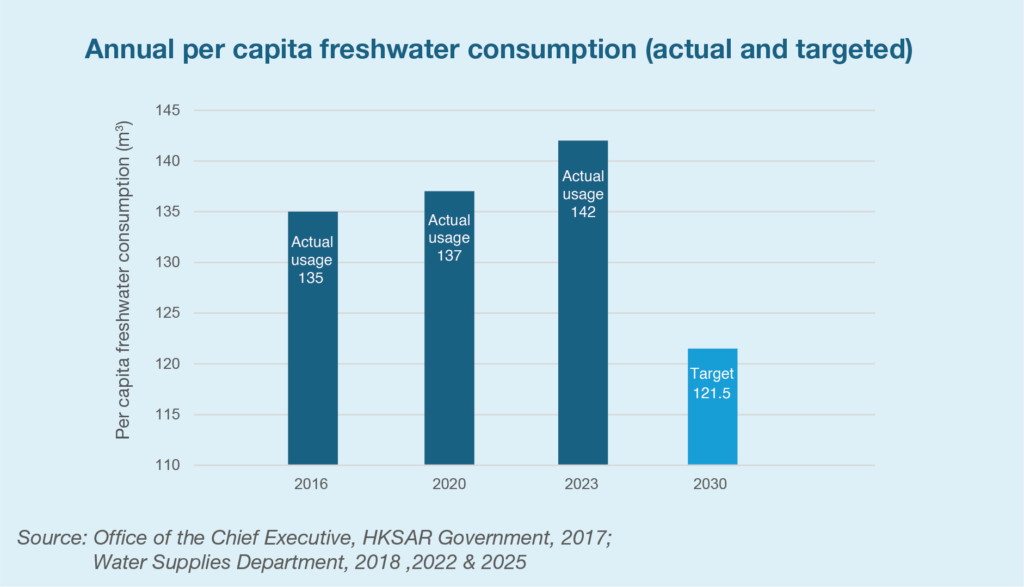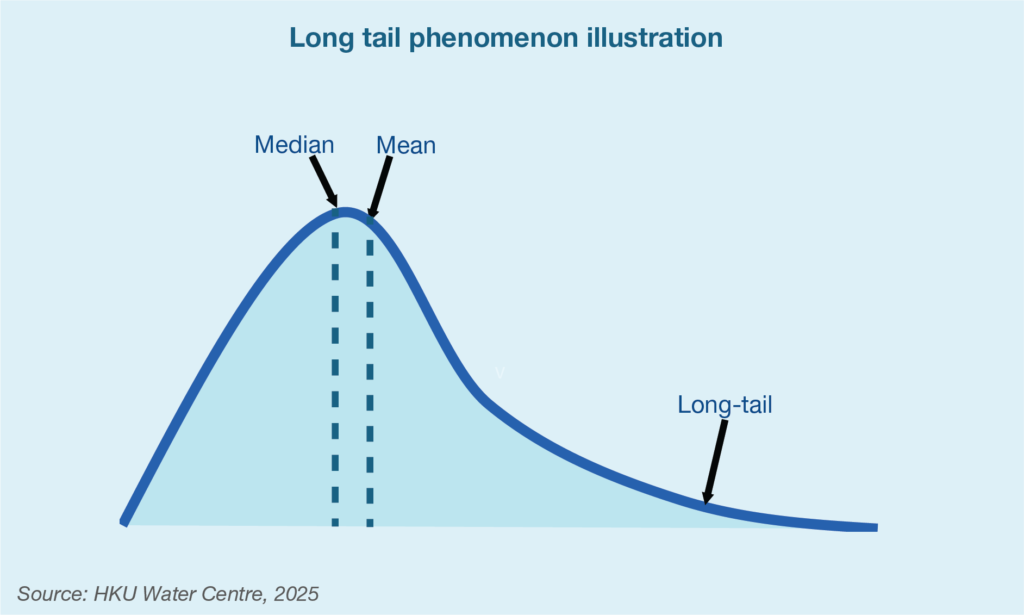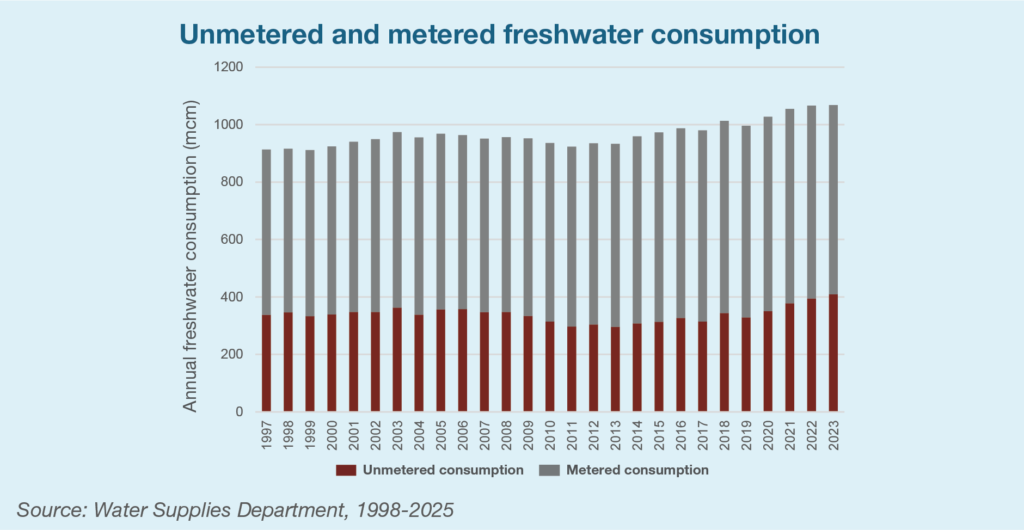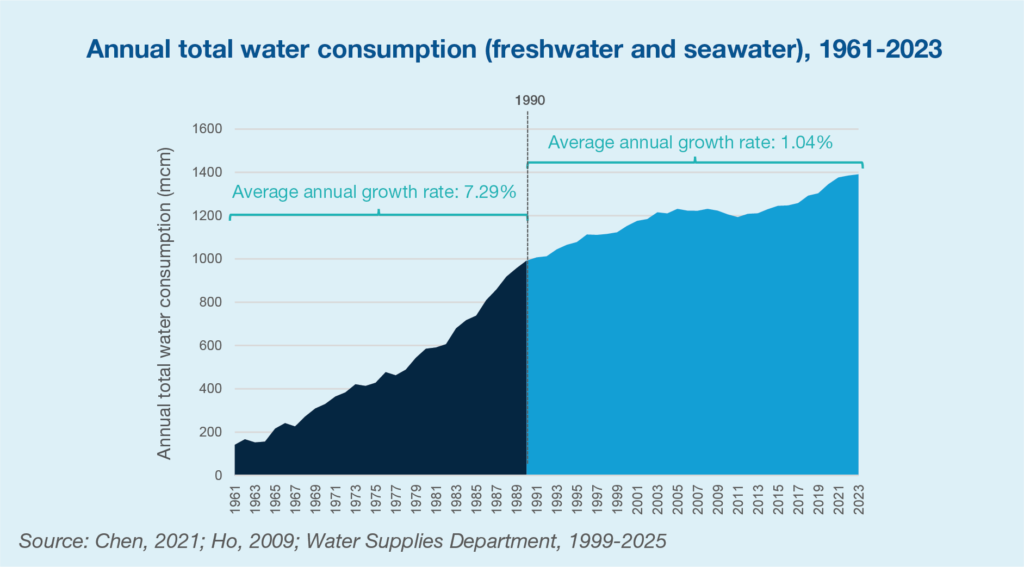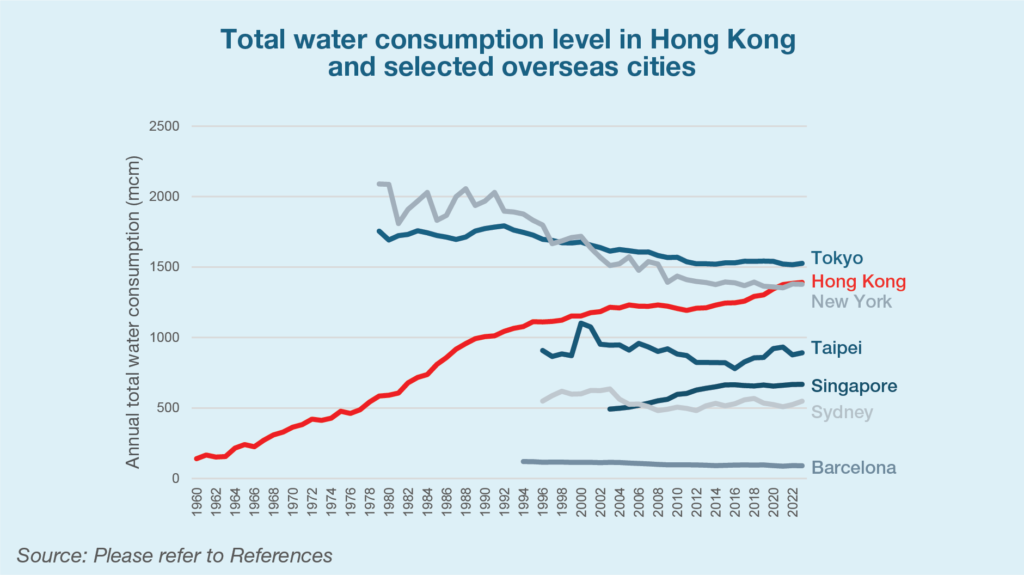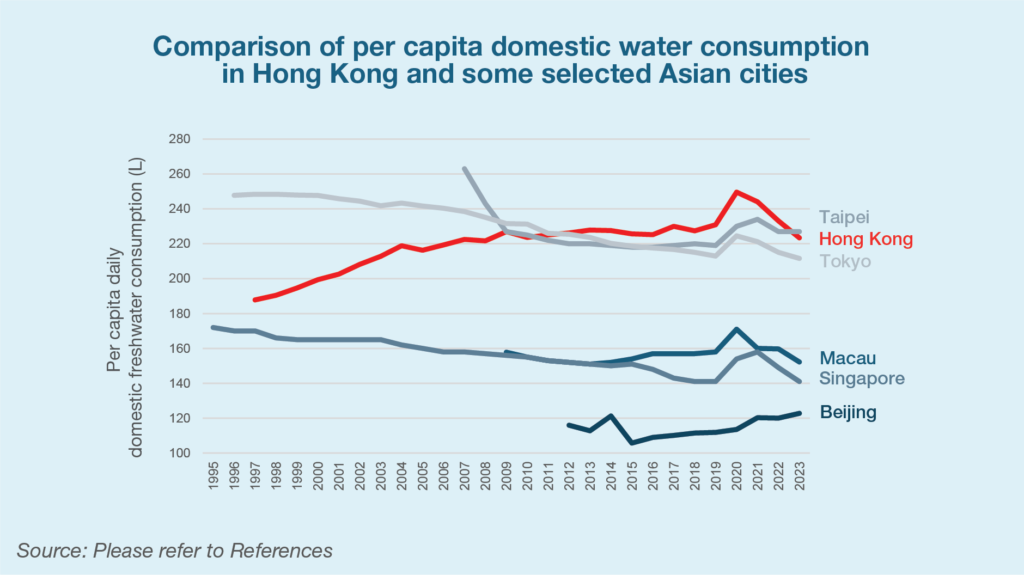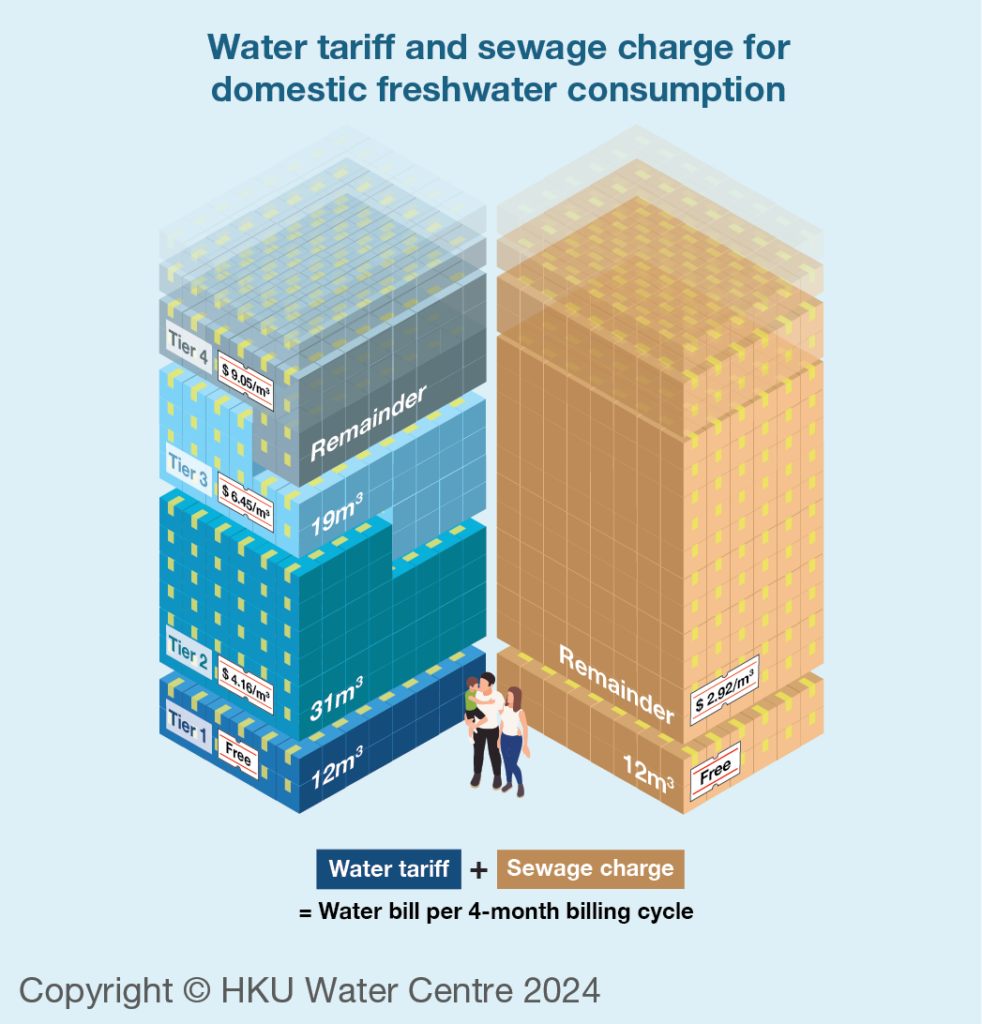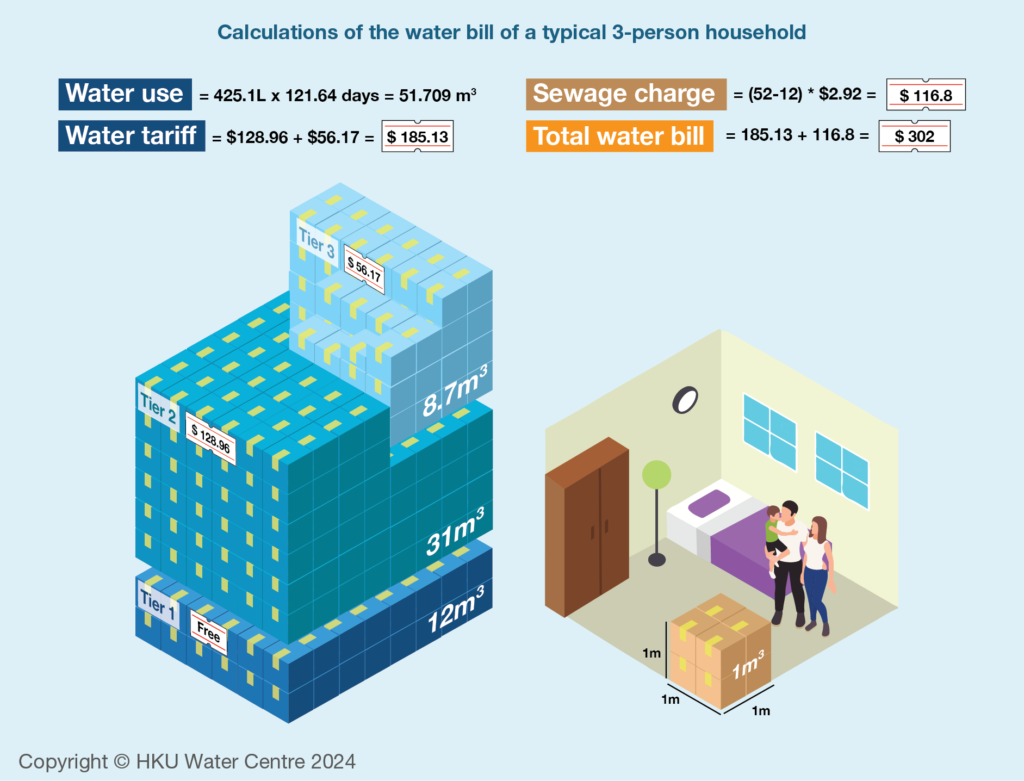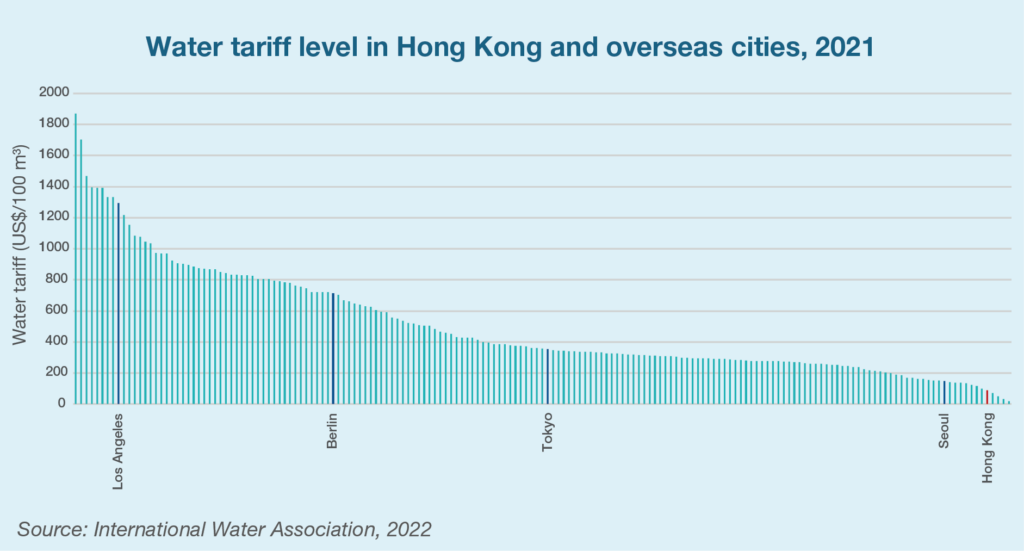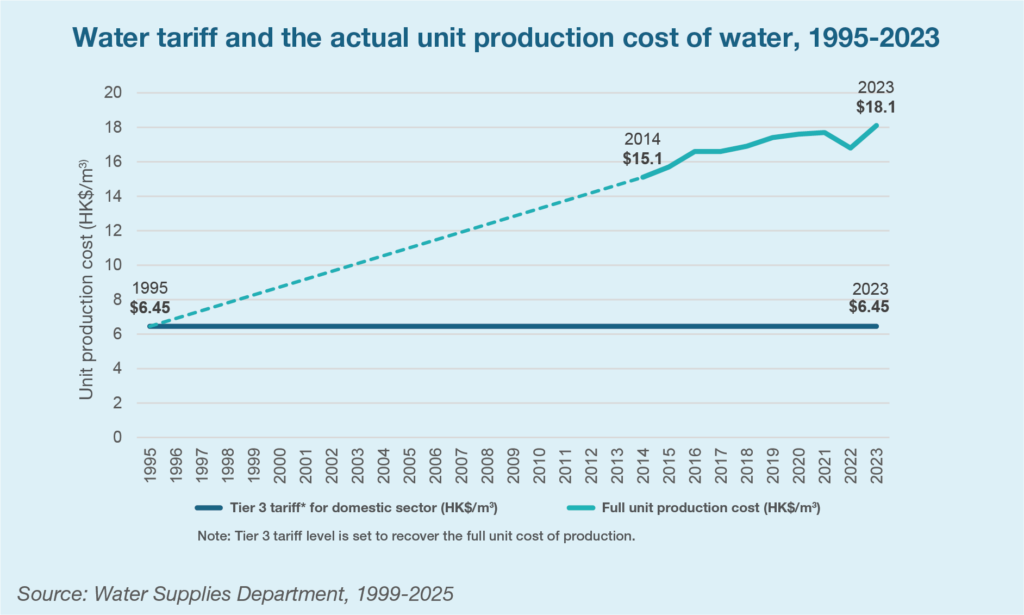
Index
How to cite
Lee, Frederick; Lee, Angela; and Lam, W.F. (2024) ‘Water Conservation’, in Lee, Frederick. (ed) Water Resources Information Portal. Hong Kong: Centre for Water Technology and Policy, The University of Hong Kong.

1. Water consumption
Introduction
Hong Kong’s water demand is met by freshwater and seawater. For instance, in 2023, freshwater resources, comprising local yield and imported Dongjiang water, constituted 77% of the city’s overall water supply. The remaining 23% was sourced from seawater.
1.1 How much water does Hong Kong consume annually?
According to the Water Supplies Department’s Annual Report 2023-24, total annual water consumption in Hong Kong was recorded at 1,391 million cubic meters (mcm). This figure includes 1,068 mcm of freshwater and 323 mcm of seawater.
The amount of freshwater consumed is equivalent to filling up 427,200 Olympic-sized swimming pools.
1.2 How much water does each person use, on average, in Hong Kong?
1.3 In what way has seawater been used to help meet local water demand?
1.5 How much tap-water does each person use at home every day?
In 2023/24, daily tap-water usage at home (i.e., per capita daily domestic freshwater consumption) was 120.9 litres.
1.7 How would the weather affect people’s showering habits?
2. Water demand management: Current situation
Introduction
Water demand management refers to policy measures that aim at controlling and reducing water consumption. Informed by an understanding of usage patterns—trends and composition, a comprehensive demand management strategy should enable the formulation and implementation of water conservation measures to effectively tackle the underlying causes of increasing levels of water consumption.
Water demand management
2.1 What is water demand management?
Water demand management denotes a set of strategies and practices that help teach people on how to use freshwater resources efficiently and to reduce the amount of freshwater consumption.
2.2 Why should we conserve water?
Individual water conservation actions, through the reduction of water consumption, could yield significant gains for the global climate system and local biodiversity conservation.
Taking a shorter shower at home, for instance, could result in a reduction in energy used for water heating. This action could also indirectly help reinvigorate drainage basin ecosystem health through river restoration projects, enabled by a reduction in abstraction of water from local and regional river basins.
2.4 What is the forecast of future annual freshwater demand for Hong Kong?
2.5 What are the major water demand management initiatives?
The major water demand management initiatives include:
- Conducting water audits to understand how much water is used or lost in the water supply system;
- Minimising water loss through leakage control;
- Implementing accurate metering for accountability;
- Structuring water rates to reflect true costs and encourage conservation;
- Analysing end-user behaviours for targeted conservation programs, and
- Formulating comprehensive plans with measurable goals.
Water conservation target
2.6 What is Hong Kong’s water conservation target?
2.7 To what extent has Hong Kong made progress in implementing its water conservation efforts?
As of 2023, Hong Kong has fallen short of expectations in water conservation.
Theoretically, the original target could be met by a steady reduction in freshwater demand at an annual rate of 0.75%.
However, the actual consumption level in 2023 reached 142 m3, exceeding the stated goal by 10.87%.
Given this trend of increasing consumption levels, a more aggressive approach is deemed necessary. It would require an annual reduction rate of 2.20% between 2024 and 2030 for the city to meet its new water conservation target, which was stated in the 2017 Policy Address.
Long tail phenomenon
2.8 What is the long tail phenomenon?
The long tail phenomenon describes a distribution where most data is concentrated at the head, with fewer high values extending into a long tail. This creates a right-skewed distribution, where the mean is greater than the median due to the influence of these high values.
For example, in a country’s per capita income distribution, most people earn relatively low to moderate incomes (the head), while a small number of high earners (the long tail) significantly increase the mean income compared to the median, which better represents the typical person’s income.
2.10 How can we achieve water conservation goals set by the government?
The long tail distribution of water consumption in Hong Kong reveals that a small number of high-usage households account for a significant portion of total consumption. To achieve water conservation goals, it is critical to target these high-conusmption households with tailored strategies to reduce their water consumption.
Water loss control
2.11 What is unmetered water consumption?
Unmetered water consumption refers to the portion of treated water that has been consumed but is not measured by any meters. Unmetered water consumption includes water losses within the water delivery system (e.g., water mains leakage) and authorised unmetered consumption (e.g., water used for firefighting and the operation of waterworks).
2.13 What is the financial impact of unmetered water consumption?
In 2023, the financial cost of unmetered consumption is equivalent to $7.40 billion. This figure is arrived at by multiplying the unmetered consumption of 409 mcm by the full unit production cost of water, officially reported at $18.1 per cubic meter.
2.14 How could Hong Kong’s water loss problem be managed?
Addressing the problem of persistently high levels of unmetered consumption in Hong Kong requires an effective management strategy.
To gain insights from a global perspective on managing water losses, the HKU Water Centre has recently prepared a research report entitled “Managing Water Losses in Urban Water Systems: An International Perspective”.
This research report summarizes important lessons gathered from examining solutions implemented by water supply agencies in six overseas cities, providing Hong Kong with an useful international comparative perspective on relevant, promising and proven methods to tackle the issue locally.
For more details, please click here.
3. Water demand management: An International perspective
Introduction
An assessment of the efficacy of local water conservation policies calls for a comparison of Hong Kong’s water consumption trends with those of overseas cities. This comparative perspective is crucial for gaining insights into Hong Kong’s relative position in relation to global trends.
Water consumption pattern
3.1 In what ways has Hong Kong’s total water consumption trajectory changed over the years?
The total water consumption in Hong Kong has undergone two distinct phases of change.
In the industrialisation phase, starting from 1961 and ending around 1990, Hong Kong recorded a rapid increase in water consumption, with an average annual growth rate of 7.29%. Next, in the de-industrialisation phase, which lasted from 1991 to 2023, total consumption level gradually stabilised, marked by an average annual growth rate of 1.04%.
3.2 Have other cities experienced a similar stabilisation trend in water consumption as that observed in Hong Kong?
Yes, many overseas cities, such as New York, Seattle and Tokyo, have undergone a similar stabilisation trend in water consumption. These cities have experienced a slowdown or a reduction in the growth rate of water consumption, which was often associated with factors such as de-industrialisation.
This phenomenon, characterised by a gradual and persistent reduction in annual growth rate of total water use due to de-industrialisation, is commonly referred to as the Maturing Water Economy effect.
3.3 How does Hong Kong’s per capita water consumption level compare to those of overseas cities?
Compared to overseas cities, Hong Kong has recorded a relatively high per capita water consumption level.
| Water consumption levels in Hong Kong and selected overseas cities, 2023 | |||
|---|---|---|---|
| Population (million) | Total water consumption (mcm) | Per capita water consumption (m³) | |
| Taipei | 2.5 | 891.5 | 356.6 |
| Beijing | 21.9 | 4070 | 185.8 |
| Hong Kong | 7.5 | 1391 | 185.5 |
| New York | 8.4 | 1377.5 | 164.0 |
| Macau | 0.7 | 89.2 | 127.4 |
| Singapore | 5.9 | 668.3 | 113.3 |
| Toyko | 13.8 | 1526.6 | 110.6 |
| Sydney | 5.6 | 548.8 | 98.0 |
| Barcelona | 1.7 | 90.9 | 53.5 |
Water tariff
3.8 What are the rates of non-domestic water charges in Hong Kong?
For trade: $4.58/m3
For construction: $7.11/m3
For non-ocean-going shipping: $4.58/m3
3.9 What is the full unit production cost of water in Hong Kong?
According to WSD’s Annual Report, the full unit production cost was $18.1 per cubic meter in 2023/24.
The full unit production cost has factored in purchase costs, treatment expenses, maintenance of infrastructure, and ensuring a reasonable return on the investments made in water facilities.


